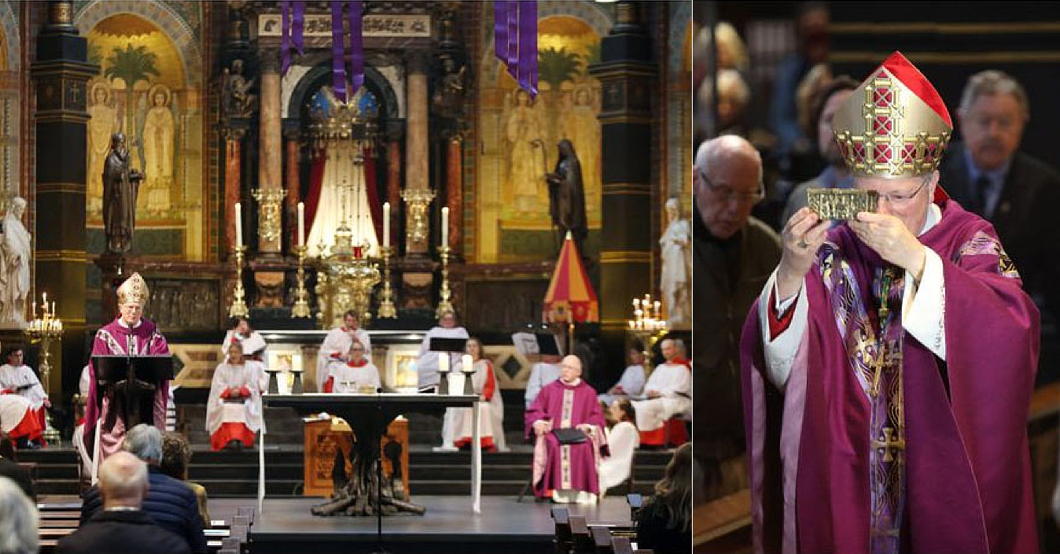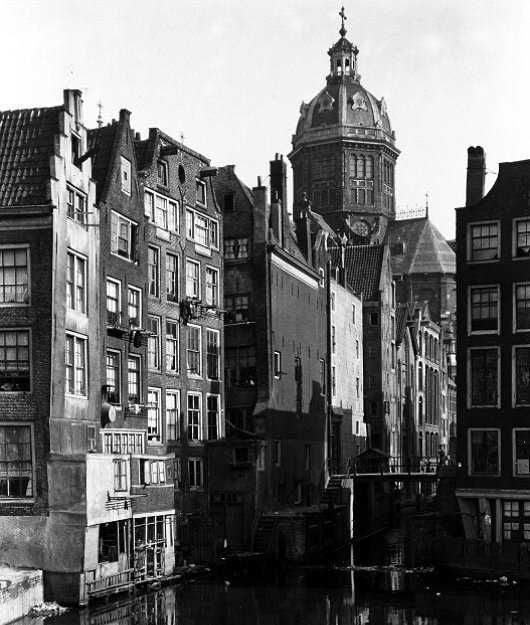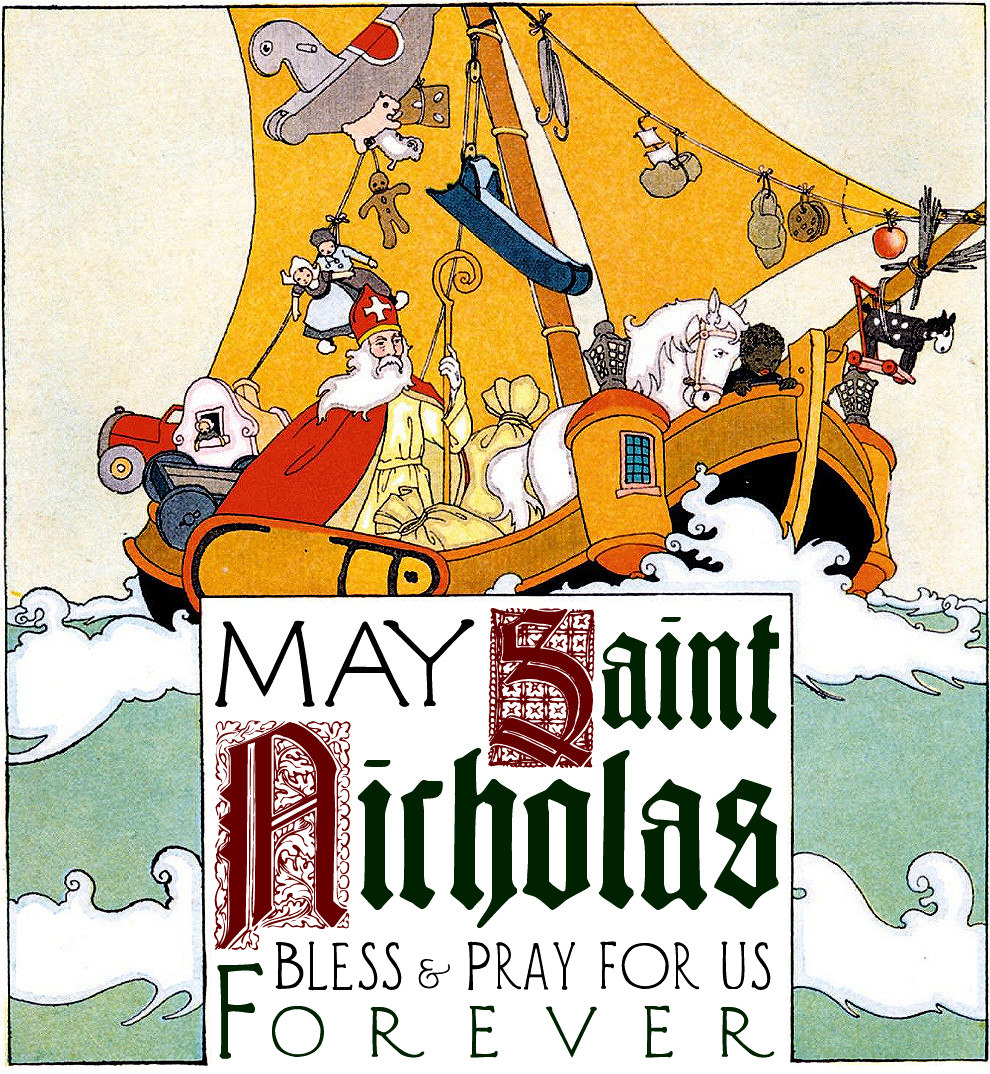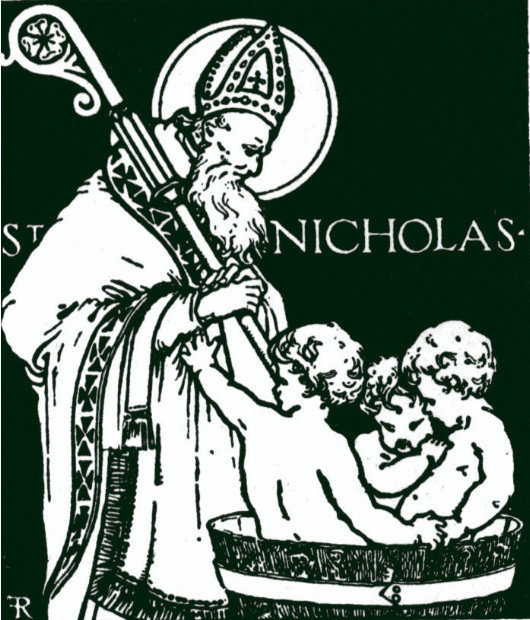Saint Nicholas
About Andrew Cusack
 Writer, web designer, etc.; born in New York; educated in Argentina, Scotland, and South Africa; now based in London.
Writer, web designer, etc.; born in New York; educated in Argentina, Scotland, and South Africa; now based in London. read more
News
Blogs
Reviews & Periodicals
Arts & Design
World
France
Mitteleuropa
Knickerbockers
Argentina
The Levant
Africa
Cape of Good Hope
Netherlands
Scandinavia
Québec
India
Muscovy
Germany
Academica
Celebrating Saint Nicholas in New York
As any fool knows, the great city of New York has as its patron and protector a great and holy saint, the wonderworker Nicholas of Myra (AD 270-343).
A great city and a great saint merit a great feast, and since 1835 the Society of Saint Nicholas in the City of New York has risen to the task of commemorating the holy bishop as well as rendering honour to our Dutch forefathers of old who founded New Amsterdam in the colony of New Netherland where the waters of the Hudson meet the Atlantic Ocean.
Blustering through the archives, it is rewarding to read of how this feast has been kept over the years.
This little snippet from The New York Times relays the St Nicholas Society’s feasting in 1877:
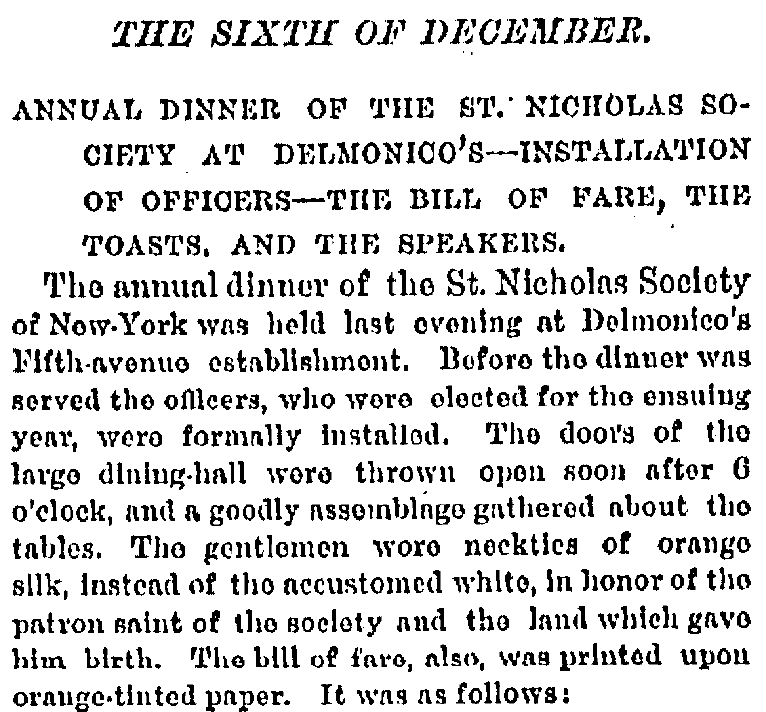
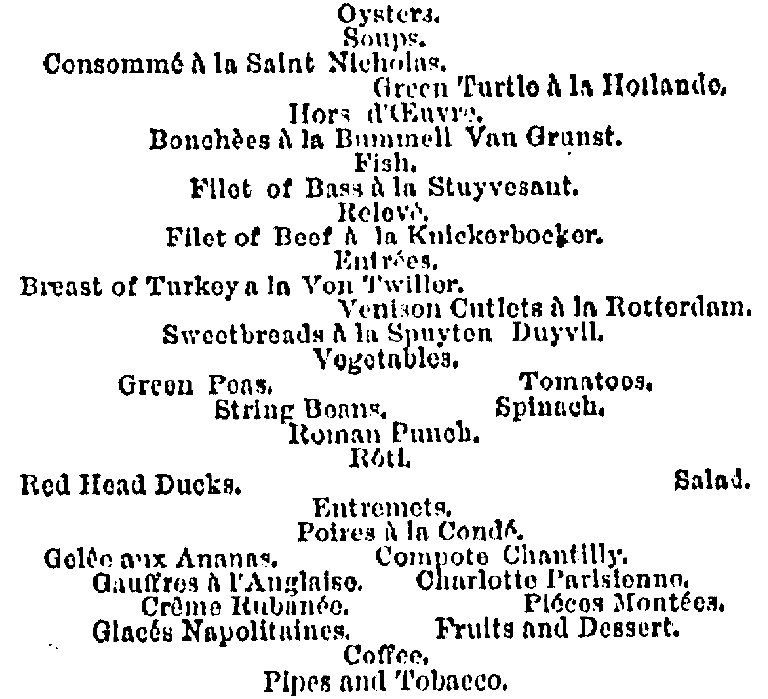
Sounds like quite a meal, but it was followed by toasts and responses appropriate to St Nicholas Day and to the city:
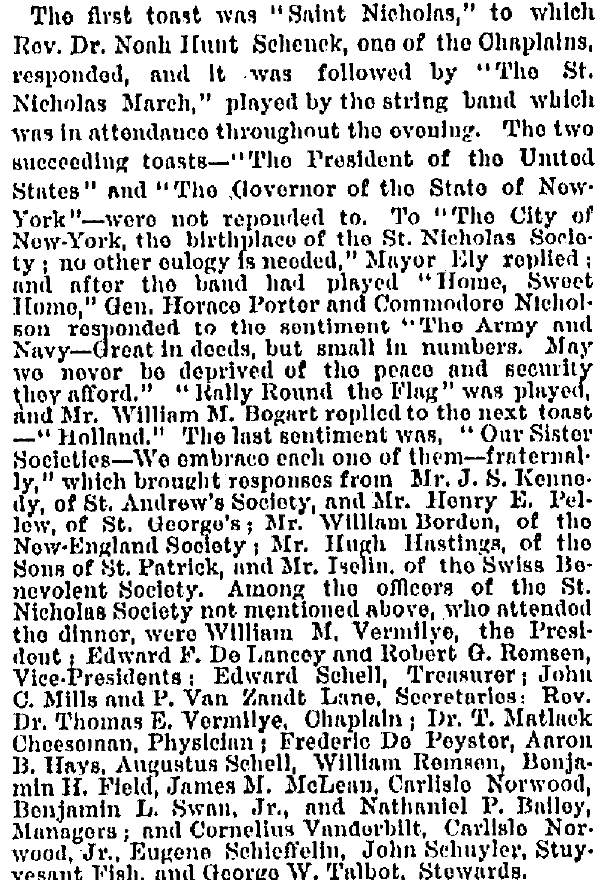
Just over a decade later in 1888, the Times again gives its report on what sounds like an amusing evening:
After an elaborate dinner had been discussed and as the coffee and long clay pipes were handed around, the old weathercock that Washington Irving gave the society was brought in and placed at its post of honor before the President, and the toast-making was begun. Austin G. Fox replied to the toast “Saint Nicholas,” and paid an eloquent tribute to the memory of W. H. Bogart of Aurora, N.Y., who had answered that sentiment at nearly every previous dinner.
The toast “The President of the United States” was drank standing and was lustily cheered. Ex-Judge Henry E. Howland made a witty response to “The Governor of the State of New-York,” touching upon every other imaginable subject but the one to which he was to respond, and James C. Carter responded to “Our City.” The Rev. Dr. J.T. Duryea spoke to “Holland,” and Warner Miller, in the absence of Gen. Sherman, replied to “The Army and Navy.” Joseph H. Choate made a characteristic reply to “The Founders of New-Amsterdam.”
The newspaper further relates that: “At the request of the St. Nicholas Society, Mayor Hewitt had flags displayed on the City Hall yesterday in honor of the festival of St. Nicholas, the patron of this city.”
In 1907, the Society’s members and guests marched into dinner at Delmonico’s two-by-two, preceded by a trumpeter and twelve servants “clad in the black and orange liveries of early Holland” escorting the newly elected president, Col. William Jay.
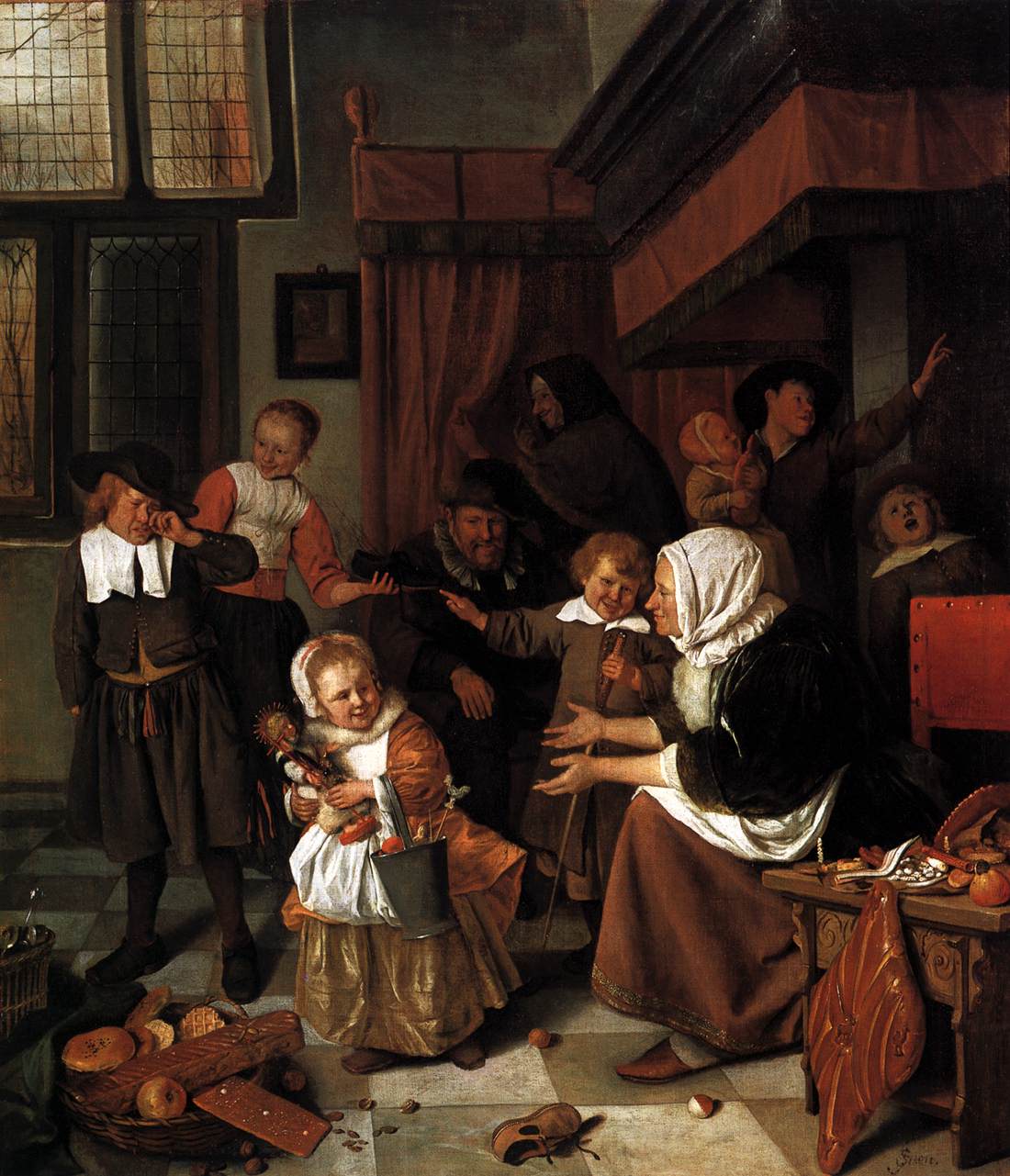
Another tradition of the evening kept each year was “the carrying round the great room of the bronze rooster that at one time surmounted the first City Hall built in New York by the Dutch in the seventeenth century”. The weathervane was presented to the Society by Washington Irving, its first Secretary, back in 1835. Some years the weathervane was oriented in turn to each speaker giving the response to the toasts accordingly.
Again, in 1907, one Dr Vandyke toasted the health of St Nicholas who “gladdens youth and makes the old seem young”. The Times relates:
“He explained that the long clay pipes which had been handed round to each guest was an old Dutch custom on St. Nicholas night. If a man got home with the pipe intact he was considered sober. Sad to relate, he said, it was the habit of those persons who had broken their own pipes to stand outside the tavern doors and break those of their more sober-minded brethren.”
While the St Nicholas Society has ancestral requirements for its membership, there are no such restrictions for the hospitable group’s guests. By the seventy-fifth anniversary of the Society in 1910, even we Irish we invited:
“William D. Murphy, who was called upon to give the toast of “Our City” said that he, an Irishman, was there at the feast for three reasons — first, because the Dutch founded the city; second, that the English took it away from them, and lastly, the Irish had it now.”
By 1919, New Yorkers were living in a changed world, with the war only just passed, and the dreaded Prohibition ever present. In that year, the Times reports that the speakers “expressed their opinions of Bolshevism, communism, and prohibition at their eighty-fourth annual dinner at Delmonico’s last night.”
Happily, these sons of Holland and devotees of Saint Nicholas kept his holy day festive despite the restrictions in place:
“Supreme Court Justice Victor J. Dowling, who was one of the speakers, expressed his thanks to the society for the Constitutional violations that had been provided for him.”
Lest you fear that the days (or nights) of celebrating this holy saint have faded into the folds of yesteryear, the Saint Nicholas Society of the City of New York is still in excellent health, and does not fail to keep the feast in accordance with the ways of its forefathers.
Indeed, the Society’s newsletter reported in 2018 that,
“Chief Steward Maximilian G. M. deCuyper Cadmus led the traditional procession of the Weathercock, which was raised high all around the room as members and guests energetically waved their napkins to generate a breeze that would waft him onto his perch near the lectern, facing east so as to crow out a warning in case of the approach of invaders from New England.”
This year the Society celebrated at the Union Club, and presented its Medal of Merit to the Harvard professor Henry Louis Gates, Jnr.
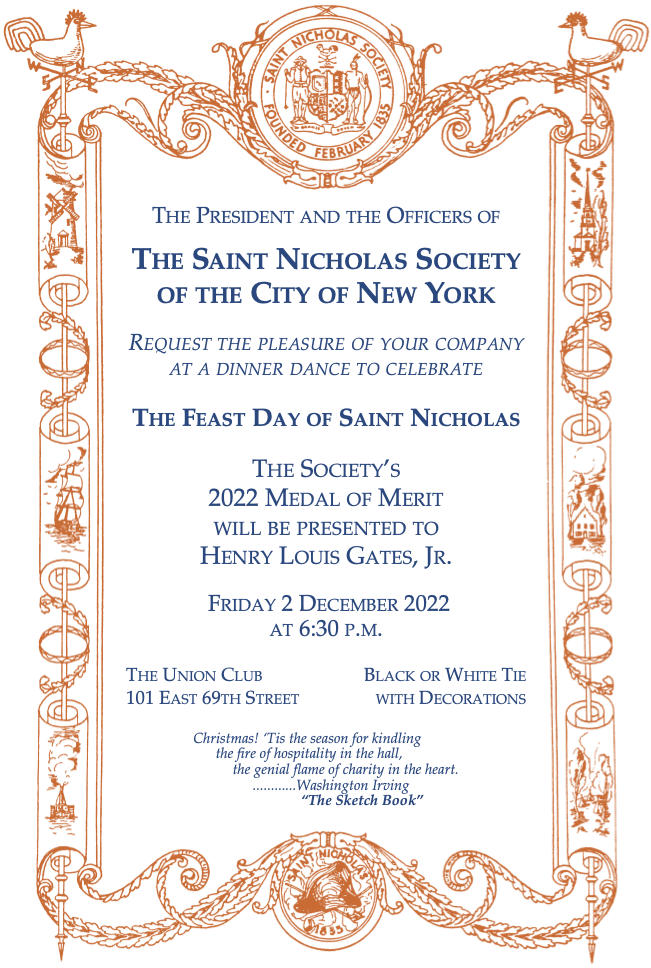
The Nicolaasjaar
Catholic Amsterdam Proclaims a Year of Saint Nicholas
A TINY RELIC of Saint Nicholas the Wonderworker has provided an excuse for Amsterdam Catholics to organise a whole year of festivities dedicated to the holy man and his legacy. The Basilica of St Nicholas stands just across from Centraal Station, gateway to the Dutch capital for so many visitors, and the parish has received as a gift the relic from the Benedictine abbey of St Adalbert’s in Egmond.
The tiny sliver of St Nicholas’s rib was enshrined in the Basilica at a special Mass opening the Nicolaasjaar on the eve of the saint’s feast in December. Bishop Jan van Burgsteden presided and prayers were also offered for HKH Princess Catharina-Amalia whose eighteenth birthday fell days later on 7 December.
The opening of the year met with wide coverage in the media, with even the website of the city proclaiming “There will always be a bit of Sinterklaas in Amsterdam from now on”.
“Saint Nicholas is really coming to Amsterdam now,” deacon Rob Polet told the evening news on Dutch television, “and here he will stay”.
“From the Friesch Dagblad to the Nederlands Dagblad, from Trouw to De Telegraaf: hardly any newspaper wanted to miss it,” the parish reports. “De Stentor, the Eindhovens Dagblad, the Zeeuwse PZC, and many other titles spread the news of St Nicholas. NRC Handelsblad and Het Parool even used it twice.”
St Nicholas, Our Patron
As by now you are all well aware, today is the feast of Saint Nicholas, the patron-saint of New York. His patronship (patroonship?) over the Big Apple and the Empire State date to our Dutch forefathers of old – real founding fathers like Minuit, van Rensselaer, and Stuyvesant, not those troublesome Bostonians and Virginians who started all that revolution business.
Despite being Protestants of the most wicked and foul variety, the New Amsterdammers and Hudson Valley Dutch maintained their pious devotion to the Wonder-working Bishop of Myra and kept his feast with great solemnity.
After New Netherland came into the hands of the British (and was re-named after our last Catholic king) the holiday continued to be celebrated by the Dutch part of the population, and was greatly popularised in the early nineteenth century by the publication of a curious volume entitled A History of New York from the Beginning of the World to the End of the Dutch Dynasty which purported to be by one Diedrich Knickerbocker.
In fact it was by Washington Irving, the first American writer to make a living off his pen, who did much to popularise St Nicholas Day in New York as well as to revive the celebration of Christmas across the young United States.
While, aside from hearing Mass and curling up with a clay pipe and a volume of Irving (being obsessive, I have two complete sets) here are a few links that shed some light on New York’s heavenly protector.
Historical Digression: Santa Claus was Made by Washington Irving
New-York Historical Society Quarterly: Knickerbocker Santa Claus
The History Reader: The 18th Century Politics of Santa Claus in America
The New York Times: How Christmas Became Merry
The Hyphen: Thomas Nast’s Illustrations of Santa Claus
– plus: Santa Claus and the Ladies
National Geographic: From Saint Nicholas to Santa Claus
Previously: Saint Nicholas (Index)
‘The Feast of St Nicholas’, Jan Steen
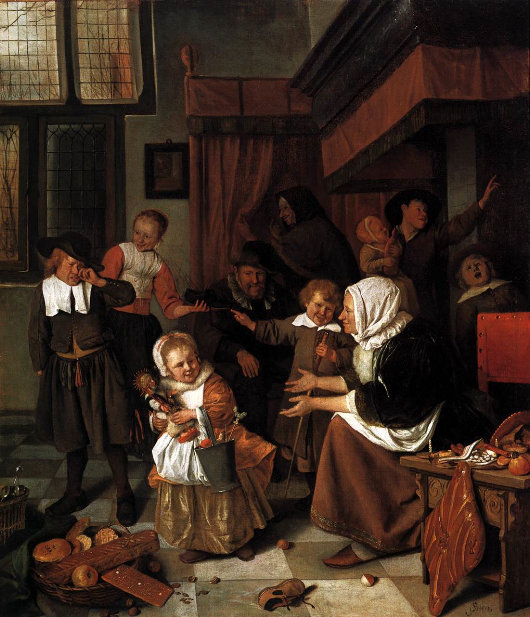
1665-68, Rijksmuseum
Patron of the Knickerbockers, pray for us
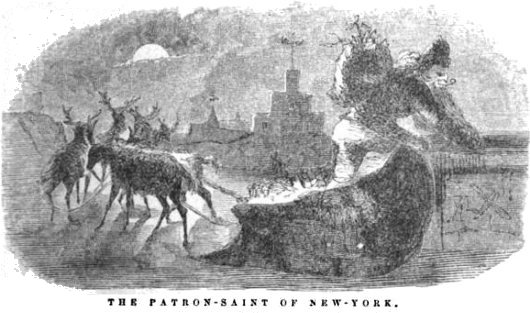
St. Nicholas of the Seven Seas
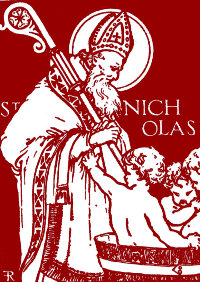 ONE OF OUR correspondents sends word that Russia is to name the fourth of her Borei-class ballistic missile submarines Николай Чудотворец, which is to say “Saint Nicholas”. The Borei-class vessels are the first series of Russian strategic submarines to be launched in the post-Soviet era. The previous subs in the class have been named the Yuri Dolgoruki (after Prince Yuri I, founder of Moscow), the Alexander Nevsky (after the Grand Prince of Vladimir & Novgorod venerated as a saint in the Eastern churches), and the Vladimir Monomakh (after the Grand Prince of Kievan Rus). The Saint Nicholas is of course not the first boat or ship to bear the name of New York’s patron saint. There was HMS St. Nicholas as well as a Spanish naval ship San Nicolas in the 1790s, eventually captured by the Royal Navy and commissioned as HMS San Nicolas. A Sealink (later Stena) ferry named St. Nicholas traversed the Harwich/Hook-of-Holland route from 1983 until it was renamed Stena Normandy in 1991 and transferred to the Southampton/Cherbourg route. Numerous merchant vessels took the saint’s name and patronage throughout the nineteenth century.
ONE OF OUR correspondents sends word that Russia is to name the fourth of her Borei-class ballistic missile submarines Николай Чудотворец, which is to say “Saint Nicholas”. The Borei-class vessels are the first series of Russian strategic submarines to be launched in the post-Soviet era. The previous subs in the class have been named the Yuri Dolgoruki (after Prince Yuri I, founder of Moscow), the Alexander Nevsky (after the Grand Prince of Vladimir & Novgorod venerated as a saint in the Eastern churches), and the Vladimir Monomakh (after the Grand Prince of Kievan Rus). The Saint Nicholas is of course not the first boat or ship to bear the name of New York’s patron saint. There was HMS St. Nicholas as well as a Spanish naval ship San Nicolas in the 1790s, eventually captured by the Royal Navy and commissioned as HMS San Nicolas. A Sealink (later Stena) ferry named St. Nicholas traversed the Harwich/Hook-of-Holland route from 1983 until it was renamed Stena Normandy in 1991 and transferred to the Southampton/Cherbourg route. Numerous merchant vessels took the saint’s name and patronage throughout the nineteenth century.
The Irving Dinner
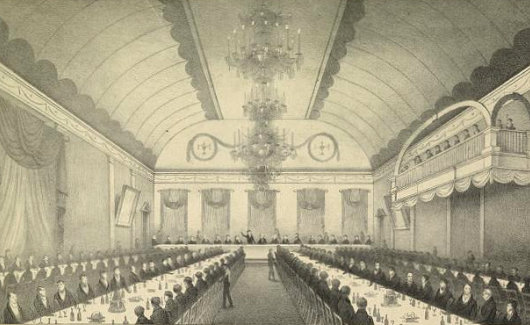
It was slightly remiss of us to neglect commemoration of the two-hundred-and-twenty-sixth anniversary of that genius of the Knickerbockers, Washington Irving. “Diedrich Knickerbocker,” “Jonathan Oldstyle,” “Geoffrey Crayon,” or, as he was baptized, just plain Washington Irving was born on April 3, 1783, exactly five months before the Treaty of Paris established the legal independence of his home state of New York and the twelve other former colonies along the Atlantic coast.
Irving was arguably the first American celebrity, and deservedly so. After a seventeen-year exile in England, France, Germany, and Spain, the author returned to New York in 1832, and a celebratory dinner was held in his honor at the City Hotel in New York on the evening of May 30. He is seen in this contemporary picture addressing those who assembled to render him honor, many of them from among the city’s political, cultural, and social elites. Indeed, the Saint Nicholas Society was founded just three years later for the preservation of the Dutch history and customs of New York, a noble task in which it continues to this day.
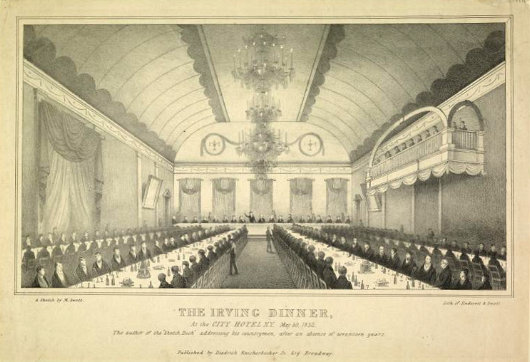
Eric Seddon on Washington Irving
Alongside Miklos Banffy, Washington Irving is probably my favourite author. I have two sets of his complete works, and will obtain at least a third — my favourite printing of the complete Irving, in an excellent handy size — when I can find it for the right price. It is curious, but by no means suprising, that Irving’s genius is nearly forgotten today even though he was the first American to be an international superstar, famed on both sides of the Atlantic. He is mostly known only through his authorship of Rip van Winkel and The Legend of Sleepy Hollow, both of which works are rarely presented in their original written form, but almost always in shortened illustrated versions for schoolchildren from publishers convinced of their audience’s stupidity.
Irving is rarely in the limelight these days, but First Things Online recently published an informative article, “Washington Irving and the Specter of Cultural Continuity” by one Eric Seddon, that is well worth reading.
His first book, Dietrich Knickerbocker’s History of New York, capitalized on the amnesia of New Yorkers by a mix of biting satire and real history of the Dutch reign in Manhattan. The book is foundational to any study in American humor. It is wild, free, self-deprecatory, and merciless to the public figures of his day, and by turns lyrically funny, absurd, and reflective. Without it, we might wonder whether American humor, from Twain to the Marx brothers to Seinfeld, would have taken the particular shape it did.
When Americans, always prone to utopian daydreams, were in danger of taking themselves far too seriously, when the term “manifest destiny” was embryonic, Dietrich Knickerbocker rolled his bugged-out eyes, chuckled gruffly, and whispered into the ear of a young nation, “Remember thou art mortal.” […]
Irving’s two most famous stories are to be found in The Sketch Book, virtually bookending the text: “Rip Van Winkle” and “The Legend of Sleepy Hollow.” In “Rip Van Winkle,” Irving whimsically pointed out the hazards of the new Republic, that a once humble acceptance of life under monarchy could easily give way to arrogant corruption, vice, and the nauseating specter of being governed by village idiots with a gift for demagoguery. […]
The final warning of the book comes in the form of a Headless Horseman, who is either a real ghost of the Revolution or the town bully in disguise, and who targets, of all people, the schoolmaster (even small towns have their intelligentsia). Is it history chasing Icabod Crane, the puritanical teacher obsessed with stories of witch hunts, or just Brom Bones scaring him out of town? Irving doesn’t say, and perhaps our answers tell more about ourselves than about him.
Washington Irving spent his last days in Tarrytown, near the setting of his most famous story. He was a member of the local Episcopal Church, tried to revive the old Dutch festivities on St. Nicholas Day, and was moved to tears by singing the Gloria. In particular he loved to repeat the words “Glory to God in the highest, and on earth peace, and good-will to men.” Though his era was in many ways a bigoted one, he resisted and thereby helped to shape a better future. One of his last revisions to Knickerbocker came late, removing the anti-Catholic references its youthful version contained. He was a man who had seen his share of specters, to be sure, but who didn’t believe they were the strongest reality.
New York’s Dutch Cathedral
The Collegiate Church of St. Nicholas, Fifth Avenue
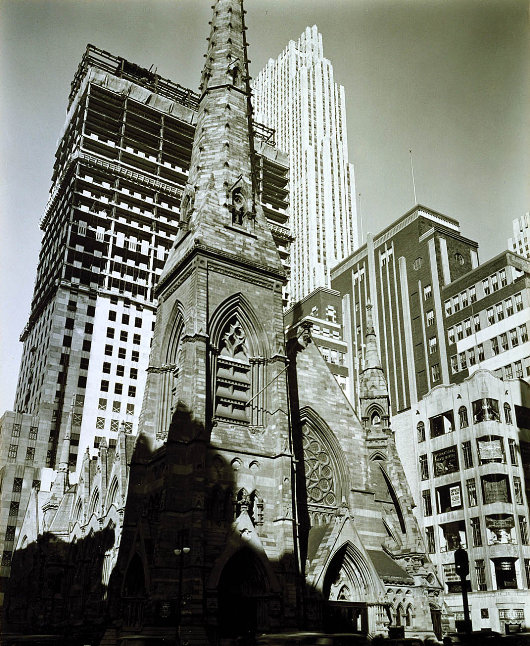
Dedicated a hundred-and-thirty-six years ago, the Collegiate Reformed Protestant Dutch Church of Saint Nicholas on the corner of Forty-eight Street & Fifth Avenue (photographed above by Berenice Abbott) was for many years regarded as the most eminent Protestant church in New York. The Collegiate Reformed Protestant Dutch Church is the oldest corporate body in what is now the United States, having been founded at the bottom of Manhattan in 1628 and receiving its royal charter from William & Mary in 1696. Now part of the Reformed Church of America, the Collegiate Reformed Protestant Dutch Church is actually a denomination within a denomination, and the remaining Collegiate Churches of New York tend to preach a sort of “Christianity Lite”. (The famous Norman Vincent Peale, author of The Power of Positive Thinking and one of the paragons of the “finding a religion that doesn’t interfere with your lifestyle” school of thought, was the pastor of Marble Collegiate Church at Twenty-ninth & Fifth, where Donald Trump is a member of the congregation).
Sinterklaasfeest
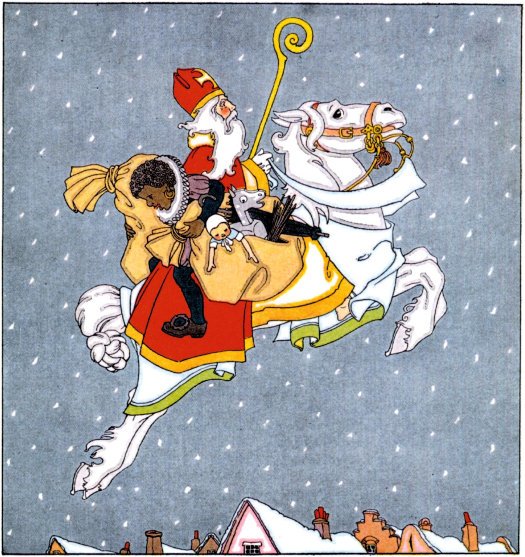
Wishing you all a very blessed Saint Nicholas day!
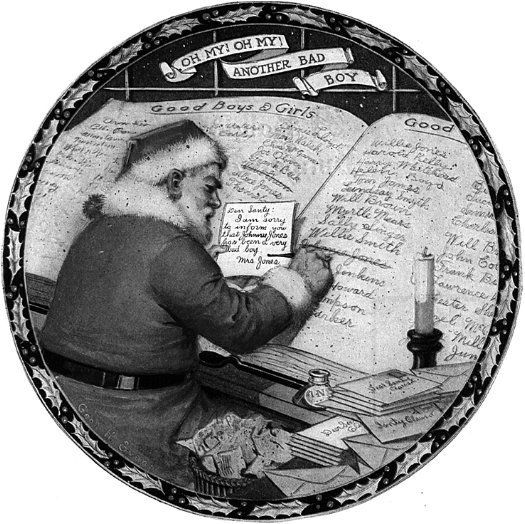
O Blessed Nicholas
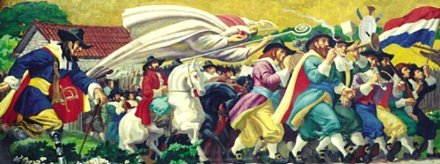
A very happy and blessed St. Nicholas Day to you all. St Nicholas is, as you all know, the patron saint of New York owing to our Netherlandish forefathers. Above you can see Lumen Martin Winter’s mural of St. Nicholas leading Peter Stuyvesant’s legion on their way to attack and take the Swedish fort of Christiania in New Sweden. The account of the battle by Washington Irving is hilarious and counts among my favorite selections of comic writing.
If you’d like to learn more about St. Nicholas, the St. Nicholas Center is a good place to start, as well as the holy bishop’s entry in the Catholic Encyclopedia.
It’s also Sofie von Hauch’s birthday. Tillykke med Fødselsdagen!
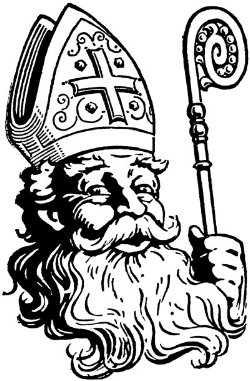
Previously: The Feast of St Nicholas
The Feast of St Nicholas

Today is the Feast of Saint Nicholas, one of my favorite saints. I’m not quite sure why he’s one of my favorites, but it probably has something to do with being the Patron Saint of New York, the greatest land there ever was. Unfortunately, he’s a somewhat neglected saint, perhaps even abused and overwritten as “Santa Claus”, the secular, materialist idol of the marketplace which has usurped both Nicholas’s heritage and subsequent reinvation a la Washington Irving et Thomas Nast.
There are many fine legends of the good Saint, most of which you can find at the most excellent resource which I highly recommend known as the St Nicholas Center.
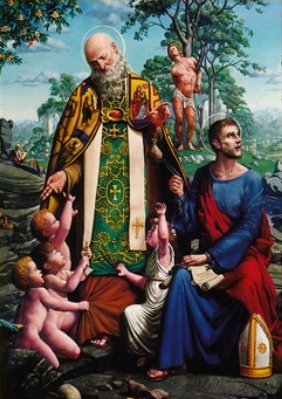
St. Nicholas was once fairly represented in the great metropolis which he watches over. Above he is seen in the sanctuary mural behind the altar at the Church of Saint Agnes – the best parish in all Manhattan. The mural was actually painted by Sean Delonas, a cartoonist for the New York Post. One of the cherubs pulling at St Nicholas is the son of the muralist.
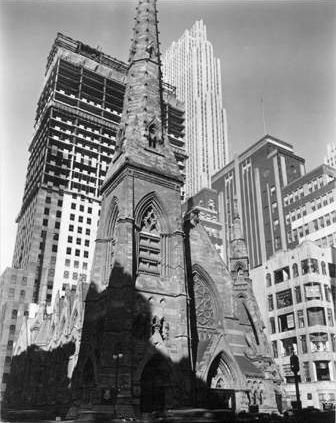
Behold, the church that was once called New York’s ‘Protestant Cathedral’. It’s hard to believe it’s gone, though I was born after it was demolished to make way for the Sinclair Oil Building. The Collegiate Church of St Nicholas was the oldest congregation in the City, founded in 1628 and housed in this late-nineteenth century building on Fifth Avenue. This photograph by Abbott shows Rockefeller Center rising in the background.
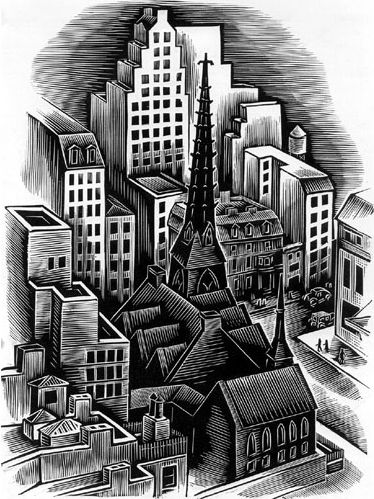
Surprisingly, the congregation – of which some of the most wealthy knickerbockers were members – did not build a new church, instead worshipping at a variety of different locations. I believe it is now dissolved, though perhaps it merged into the West End Collegiate Church.
Good Saint Nick…
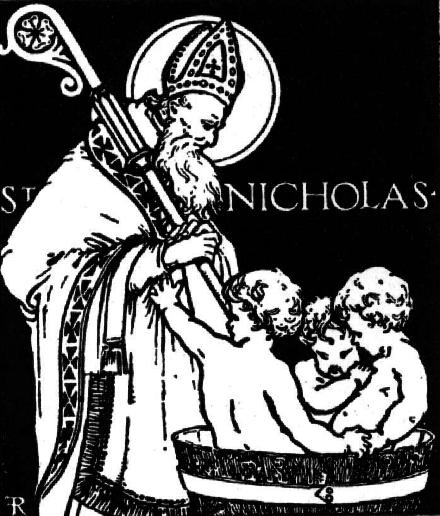
Thanks to our Hollandic foundation, Saint Nicholas is the patron saint of New York. The Saint Nicholas Center has a great website telling you all about good Saint Nick, including this page with tips for celebrating the Saint from none other than the great Joanna Bogle.
Joanna is a brilliant woman who I had a great conversation with after her talk ‘Does the Catholic Church Oppress Women?’ at Canmore during Martinmas term. Mrs. Bogle (whose other half is Jamie Bogle, another UK activist who has visited St Andrews) is a no-nonsense public speaker as well as a brilliant journalist covering issues relating to ethics, conception-to-natural-death, the Church, and women, her most interesting work being on culture. I hope to purchase her Book of Feasts and Seasons sometime soon.
His feast, December 6, is also the birthday of Miss Sofie von Hauch, good friend and Scandinavian femme fatale of polyphony who will be forever remembered for bringing Latin back into our parish’s liturgy at university.
Search
Instagram: @andcusack
Click here for my Instagram photos.Most Recent Posts
- Sag Harbor Cinema March 26, 2025
- Teutonic Takeover March 10, 2025
- Katalin Bánffy-Jelen, R.I.P. March 3, 2025
- Substack Cusackiensis March 3, 2025
- In the Courts of the Lord February 13, 2025
Most Recent Comments
Book Wishlist
Monthly Archives
Categories

